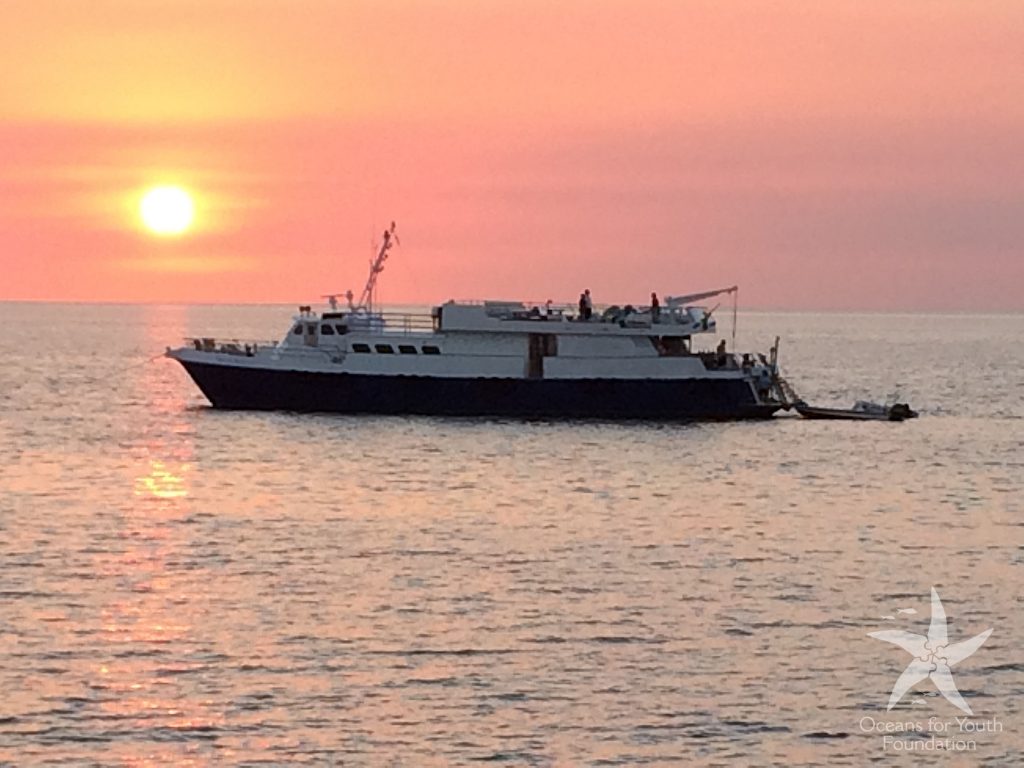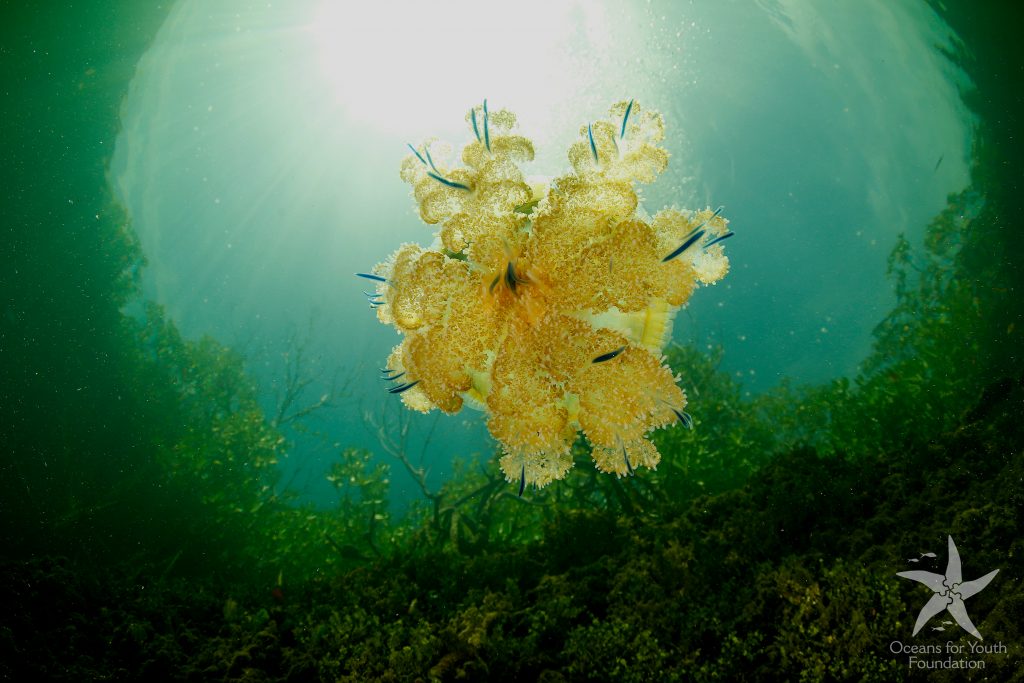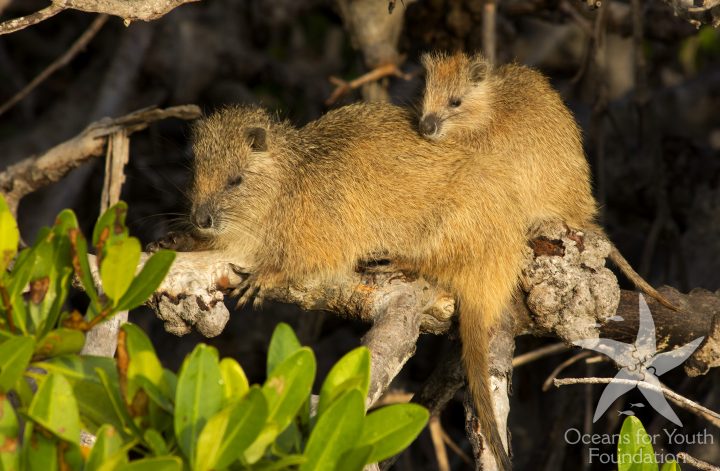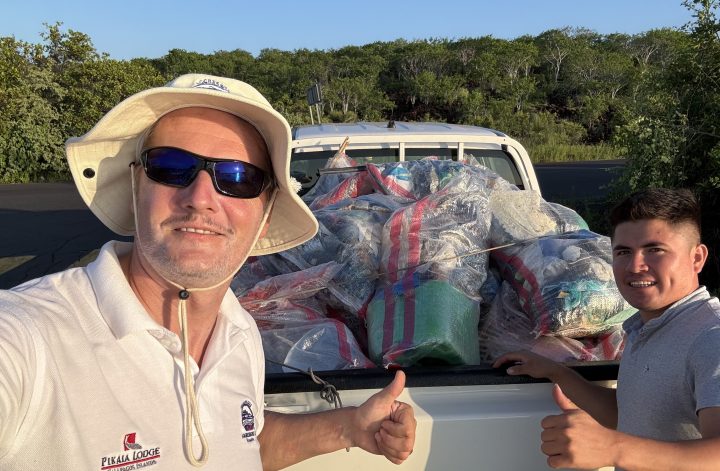By Samantha Whitcraft, Director of Conservation & Outreach, Aggressor Adventures® & Oceans for Youth Foundation
The Gardens of the Queen National Park, Cuba is the largest marine park in the Caribbean (840 square miles or 2,170 km2). Working from aboard the M/V Oceans for Youth, a dedicated research and education platform, Cuban scientists monitor the thriving coral reefs and abundant fish life that are unique to the region including stony corals, groupers, and sharks. The long-protected reefs show little sign of disease or bleaching. In addition to the documented recovery and resilience of threatened coral populations, long-spined sea urchins also seem to have recovered locally to a greater extent than the rest of the Caribbean. Additionally, the park’s many small islands provide protection for the critically endangered Cuban crocodile (Cocodrilus rhombifer), a rare mammal, the endemic Cuban hutia (Capromys pilorides), and vital nesting beaches for sea turtles – both green (Chelonia mydas, endangered) and hawksbill (Eretmochelys imbricata, critically endangered). Another endemic species, a rare Cuban palm tree can also be found on some of the islands. The shorelines of the mangrove fringed islands also provide nursery habitat for young fish such as vulnerable Goliath groupers (Epinephelus itajara). While in the surrounding waters, much of the well-protected reef crest is dominated by large, healthy stands of critically endangered elkhorn coral (Acropora palmata). And in the reef flats, clusters of critically endangered staghorn coral (Acropora cervicornis) grow.

This ecosystem is world renowned for abundant marine life, and successful management that protects the entire coastal ecosystem and islands – from the mainland coast, out across a large bay of shallow seagrass and beyond to the intact fringing reefs. The extensive, healthy seagrass beds provide natural filtration from land-based run-off helping to keep coastal waters clean and healthy. Studies suggest that when this happens, mangroves, seagrass beds, and reefs can support more marine life. And here, they do.
Why is this ecosystem comparatively so healthy? Local scientists, with support of the Oceans for Youth Foundation, are collecting data to answer this important question.
In 2018 an embargo on the publishing of Cuban marine science in the U.S. was lifted and a special edition of the peer-reviewed Bulletin of Marine Science was released focusing exclusively on the science and conservation of Cuba’s marine and coastal ecosystems. The result was a clearer understanding of the status of Cuban marine science and marine resource management challenges and success throughout Cuba and in the Gardens of the Queen National Park. The published papers included studies of how over-fishing and urban pollution have negatively affected the coral reefs off the more populated areas around Havana versus the conservation successes of more remote marine protected areas, and how Cuban land use overall, and the lack of wide-spread fertilizer application has helped protect many of their coral reefs.
Current published science from Cuba combined with the on-going scientific monitoring efforts of the M/V Oceans for Youth scientists and staff are relevant to and important for international marine education in three ways.
First, there are no hard borders in the waters and currents that connect the marine life off the coasts of Cuba and the rest of the Caribbean; understanding that biological connection is paramount to effective regional conservation efforts.

Second, fostering the exchange of scientific information and knowledge between the scientists and students across nations is a positive step for marine education, public awareness, and international ocean literacy.
And third, understanding that the Gardens of the Queen National Park represents a rare and near pristine baseline of an intact Caribbean coral reef and coastal ecosystem providing an unapparelled opportunity for marine science education.
Science-based management has been in place since 2005 with annual surveys by scientific staff stationed in the park aboard the M/V Oceans for Youth. For example, in 2019, a team of local scientists surveyed 32 beaches documenting 236 hawksbill sea turtle nests and 683 green sea turtle nests. The data helped managers better understand the status of the park’s sea turtle populations and what areas to patrol more often. Additionally, Cuban scientists working in the park have documented coral spawning suggesting the reefs may serve as important sources for new coral colonies via down-current dispersal of coral larvae within the park, and perhaps even beyond to the wider Caribbean. The park’s corals are kept healthy by the cooling waters of the offshore currents and by the presence of abundant grazers such as long-spined urchins (Diadema antillarum), whose populations are declining in other areas of the Caribbean. These important grazers feed on turf algae keeping the substrate clear for the recruitment of new corals and growth of existing colonies. The abundant corals, in turn, provide ideal habitat for not only many species of reef fishes but also a readily apparent and impressive high biomass of fish.
The Gardens of the Queen ecosystem provides unique marine education opportunities for U.S. and international educators and their students via the Oceans for Youth Foundation’s Classroom-at-Sea programs. Now, with the Oceans for Youth Foundation and from aboard the M/V Oceans for Youth teachers, students of all ages, and conservation non-profits can return to explore and learn more about this jewel of the Caribbean. The returning seven-night educational program operates throughout the Park’s archipelago of islands via snorkeling (and four optional scuba dives) and visits across the park’s habitats including unique lagoons, remote islands, pristine mangrove forests, extensive seagrass meadows, gorgonian dominated shallows, and deep coral reefs. Students can expect to see and learn about sea turtles, groupers, and sharks every day along with massive schools of colorful reef fishes amid a background of large stands of golden, branching corals.

The M/V Oceans for Youth’s Classroom-at-Sea Program is for high school (age 15 or older), college, university, scouting or other non-profit based educational groups interested in studying marine biology or ecology in the field. Participants will spend seven nights on the vessel exploring the habitats of the Gardens of the Queen National Park. Throughout the week, Cuban marine biologists guide daily expeditions and provide daily seminars about the wildlife, habitats, and the ecological importance of each. The theme of the week will focus on how Cuba’s conservation and management efforts in the national park have maintained one of the healthiest marine ecosystems in the Caribbean. Due to the near-pristine condition of the park’s protected, interconnected coastal habitats – mangroves, seagrass, and coral reefs – educational opportunities in the area provide students the rare experience of witnessing the beauty of how truly healthy Caribbean marine ecosystem functions.
The provided course curriculum, Dynamics and Conservation of Cuban Coastal Ecosystemsis field-based and taught by Cuban scientists working and conducting field studies from on board the vessel. Daily seminars topics focusing on Cuba’s marine ecosystems include:
• Ocean Zones and Coastal Communities
• Lagoons and Mangroves
• Seagrasses and Coral Reefs
• Oceanographic Processes and Coastal Ecosystems Interactions
• Fisheries Management and Coastal Ecosystems
• Marine Protected Areas Management
• Jardines de la Reina Management Plan – Development and Implementation
All seminars are taught to the appropriate group’s academic level i.e., high school or university – undergraduate or graduate level. The one-week course provides seminars at the Introductory Level (best for high school and undergraduate students) and a two-week course (best for graduate students) provides seminars at the Advanced Level.
Customized educational content is also available upon request such as customized charters and itineraries of 2-4 weeks or semester-at-sea options. Educational institutions may provide their own curriculum and/or integrate theirs with educational content provided by on-board Cuban scientists (in English and/or Spanish).
The M/V Oceans for Youth’s motto is “Explore, Learn, Protect”. It is a 100-ft. motor vessel built for safety and stability and sleeps up to 24 passengers with a crew of eight. The vessel’s main salon provides a large teaching space complete with laptop hook-up and projection screen. A small library includes species ID guides and other natural history books and videos. The Oceans for Youth Foundation’s onboard educational programs are available to U.S. citizens via the foundation’s People-to-People authorized general license.




